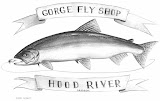Size
It should be no surprise that fish see big flies better than they see small flies. Not only that, larger flies may send greater vibrations through the water column that fish hear or detect along their lateral-line flanks. If water visibility is low, give them something larger to look at and/or hear. If you step into the river up to your knees and can only see the vague outline of your boots, then tie on a large fly. Furthermore, try fishing these patterns in a broadside manner – with a very slight downstream belly in your line – as opposed to a straight line swing where the fish only sees the butt of the fly.
Conversely, traditional thought for overly clear river conditions tends towards smaller and/or sparser flies. Conventional hair wing flies and small marabous are pretty good choices to lead the way in these conditions. Growing in popularity, many new midsize flies have joined the ranks. Notorious sink-tip flies like Intruders and leeches are now available in smaller sizes, lending great versatility in all conditions.
Color
Ok, I’ll say it: “Bright day -> Bright Fly. “Dark Day -> Dark Fly.” I can say that I follow this rule more times than not. Is this crucial? Again, hard to say. What is known is that darker flies have a tendency to silhouette – show their outline – better than lighter-colored flies. When the sun is out, brighter colors may help to add a little flare or attitude to the pattern.
Often times in sunny, clear-water conditions, people reach for more natural-toned flies – especially inland, where fish may have been living in freshwater for a long time. Browns, blacks, olives and grays resemble surrounding hues, and may seem more credible in low, clear conditions.
When river clarity is down and flowing somewhere between green and brown, I like to twist on some large, bright flies when the sun is high in the sky. Big orange or even pink marabou patterns really stand out in these conditions and lend an alluring glow through the water.
Flash
Many, many fly patterns today are tied with at least some amount of flash. Whether or not there is a stark difference between a fly tied with a couple strands of flash and one without any at all, is tough to say. There are however some flies that have a lot of flash and when the sun strikes these flies, they really stand out. To a fish, this has to be a serious attention grabber. So during bright days I usually try, at least for a spell, a very flashy fly and I am often amazed by the fury of the take when they do commit. One thing about flash that I always try to mention is that if you see any spinner anglers around, pay careful attention to them. If they are hooking fish, then by all means pick out your flashiest fly for a trial run.
What to grab out of your fly box when what you are using is not working
I tend to grab a fly that is different – different in either size, color, the amount of flash or all of the above. Many of you have heard: “The Problem is Not the Fly,” and this may very well be the case. When pinned against other factors such as what water you choose to fish and how you present your fly, fly choice seems but a measly concern. But the way I look at it is, it can’t really hurt to try something different and furthermore, I would rather at least change up the club when I’m beating that dead horse.
If you haven’t already seen it, Skagit Master 3 dives into the world of steelhead flies and sheds some light on this age-old discussion.
Have a good time,



















.jpg)





No comments :
Post a Comment